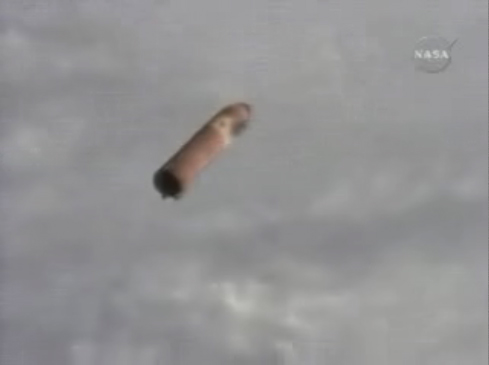NASA Weighs Heat Shield Dings on Shuttle

NASA is not too worried about debris that appeared to fallfrom the space shuttle Endeavour's external fuel tank during its liftoffWednesday, but is perplexed about why the bits of foam insulation fell from anunexpected spot.
During Endeavour'slaunch, about nine to 12 bits of debris appeared to fall, though most ofthese occurred after the period where falling pieces are likely to causedamage.
Two debris events appear to have struck the shuttle whenthey could cause damage, and what appeared to be slight coating damage on sometiles was seen in launch video footage, mission managers said. Endeavour?s heatshield will get a full standard inspection to determine its health during themission, they added.
Insulating foam from the tank can impact the orbiter anddamage the sensitive heatshield tiles and panels lining its belly, nose and wings.
Mission managers were surprised by the pattern of foam lossseen on Endeavour's external tank, as it fell in long slivers from the middlearea of the tank, which hasn't been a problem before.
They plan to study the problem by analyzing other externaltanks on the ground being prepped for future missions to see if the foam inthis area is loose on other tanks. The work could potentially impact theplanned launch dates of future flights, but it's too soon to tell, said missionmanagement team chair John Shannon during a Thursday briefing.
"Strips of the foam covering the inner tank structurejust kind of peeled off the primer layer of metal," Shannon said. "Wedon?t understand why that actually happened. It looks like the base primer wasnot holding on to the foam well."
Get the Space.com Newsletter
Breaking space news, the latest updates on rocket launches, skywatching events and more!
Though the pattern is unusual, it doesn't appear to pose aserious threat to the shuttle this time.
"The foam loss was so late there was not a lot ofaerodynamic forces going on at that point," Shannon said. "We're notworried about this flight but we need to understand what was going on for thenext flight."
To be sure that Endeavour is safe and its heat shieldunscathed, NASA has a number of normal precautions in place.
Astronauts aboard the shuttle spent about seven hours todayporing over the heat-resistant reinforced carbon-carbon panels liningEndeavour?s leading wing edges and nose cap, using a sensor-tipped inspectionpole. That data is yet to be analyzed in detail, but no warning signs werereported so far.
The shuttle is scheduled to dock at the InternationalSpace Station tomorrow at 1:55 p.m. EDT (1755 GMT). As the vehicleapproaches, it will make a fly-around to expose Endeavour's underside whileastronauts aboard the station snap detailed photographs. Those will be sentdown to engineers on the ground to search for possible damage.
Endeavour is beginning a 16-day mission to deliver a Japanese-builtoutdoor science platform and a new long-duration crewmember to the station.The mission was delayed for more than a month on the ground by bad weather anda gas leak, but is now proceeding smoothly, lead flight director Paul Dye said.
"Our team is sharpand ready to execute the mission," he said Thursday. "The bestthing about today was that there wasn't much off-nominal. The crew's been aheador on schedule all day."
- New Video - The Kibo Lab: Japan's Hope in Space - Part 1, Part 2
- Final Countdown: A Guide to NASA's Last Space Shuttle Missions
- SPACE.com Special Report - THE MOON: Then, Now, Next
SPACE.com is providing continuous coverage of STS-127with reporter Clara Moskowitz and senior editor Tariq Malik in New York. Click here for missionupdates and SPACE.com's live NASA TV video feed.
Join our Space Forums to keep talking space on the latest missions, night sky and more! And if you have a news tip, correction or comment, let us know at: community@space.com.

Clara Moskowitz is a science and space writer who joined the Space.com team in 2008 and served as Assistant Managing Editor from 2011 to 2013. Clara has a bachelor's degree in astronomy and physics from Wesleyan University, and a graduate certificate in science writing from the University of California, Santa Cruz. She covers everything from astronomy to human spaceflight and once aced a NASTAR suborbital spaceflight training program for space missions. Clara is currently Associate Editor of Scientific American. To see her latest project is, follow Clara on Twitter.









